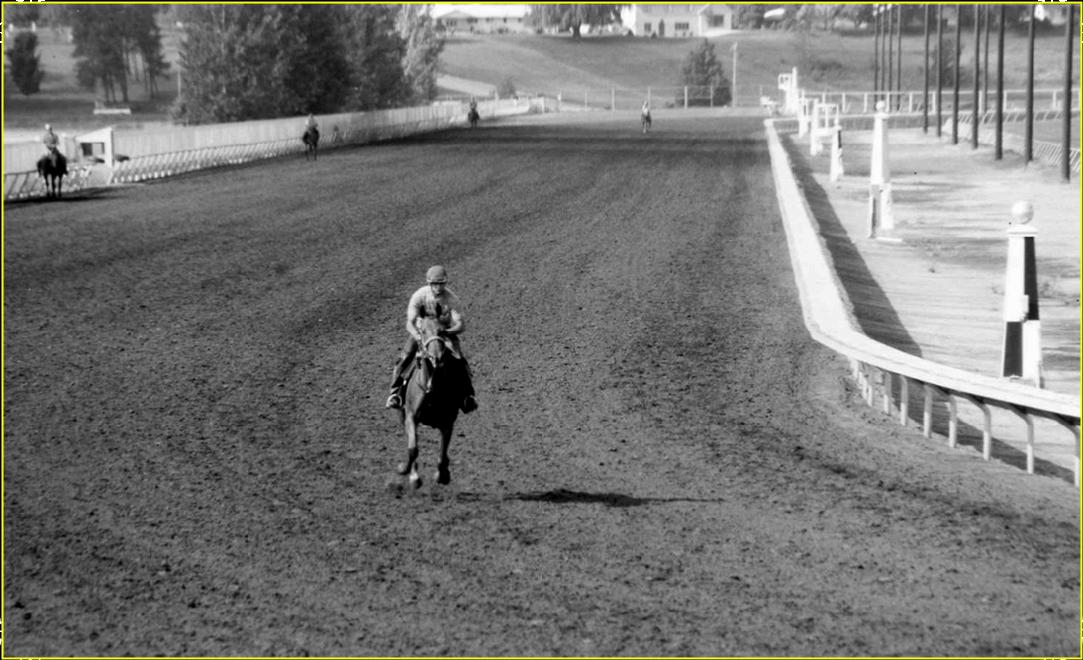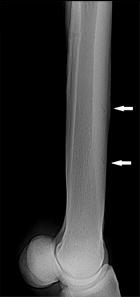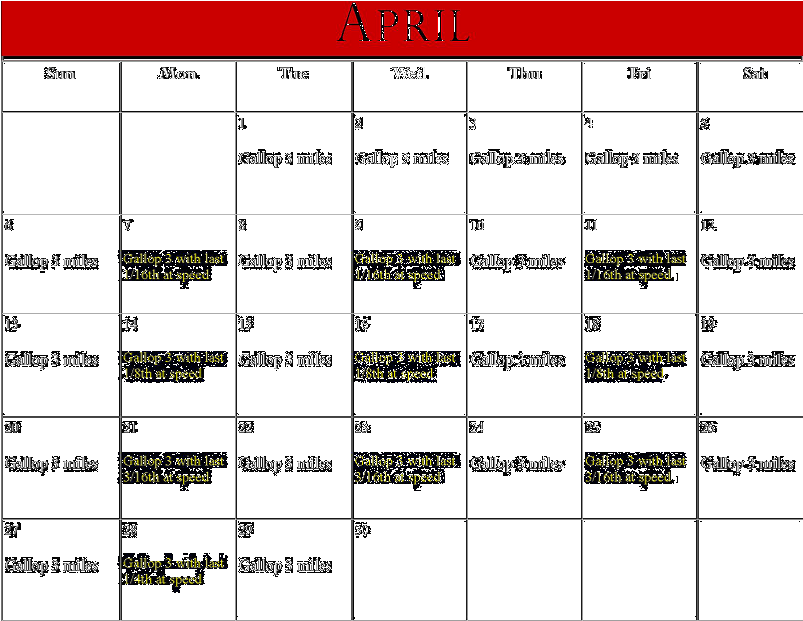When dealing with bucked shins, it is particularly true that an ounce of prevention is worth a pound of cure with a lot less heartache. So I am going to tell you how easily it is not to buck shins first before I touch on treatment. You hard-core, dyed in the wool typical conditioners will probably scoff at me, but so be it. Continue doing what you have been doing for so long, even if you were mentored by the best. By the way, how has that been working out for you and your colts/fillies?
Personal fact: I am not trying to sell anything here other than a new way to start youngsters. I have developed and raced many Thoroughbred homebreds and have never been forced to stop my training or racing because of bucked shins. The above and below photographs are of me starting two of my typical green unraced three year olds using this method with neither and all of the others never bucking shins. I differ from most Thoroughbred trainers in that a large part of my racing background was devoted to harness racehorses where we tend to condition for stamina, soundness, and appreciate a solid foundation in our horses. Of late, it seems most Thoroughbred trainers have come from the quarter horse ranks and it shows. We all know how little stamina conditioning means to those boys and how they like to race their horses "
fresh" which is code for stall rest!
I never thought too much about it at the time when I switched over to the Thoroughbreds, but now hearing so much about shin bucking, I appreciate how lucky or "skilled", I was. I was probably a little bit of both. I originally thought until a few years ago that my lack of being cursed with bucked shins in my young horses was probably due to my atypical habit of galloping my horses along at a nice brisk rate at a bit longer distance than the norm. I would guess, I would gallop at around the 3-4:00 minute speed for a mile while going typically three miles. It seems to me most exercise riders prefer to lope around the track very slowly, few seem to want to make the horse "work" much even at the slow speeds of galloping. At any rate, that was what I believed until I read the article, "Training Young Athletes" by Sushil Dulai Wenholz from the October issue of "The Horse" and this article was based on the Maryland Shin Study. The basic synopsis of this article is that slow work really does not affect the likely hood of decreasing bucked shins, no matter how much mileage is involved. It says that short speed work is the key. One must stress the bones of the young horse to tell them how best to remodel for a life as a racehorse. Not stressing young bones with early speed work will never result in bones that can counteract the stresses of race speeds well. It goes on to describe a training regime that was implemented by Dr. Fisher which I will quote below:
"...John Fisher, DVM, a veterinarian and racehorse trainer, set out to see if he could develop an optimal program to use on the horses in his barn. The schedule he came up with starts with basic conditioning. Once a horse could comfortably go one mile with furlongs at 18-20 seconds each, Fisher began introducing speed work twice a week, using a pace of one furlong per 15 seconds, and starting with a one furlong distance. Every three to four weeks, he increased the distance by another furlong. By the end of three months, the horse was doing 3/8ths mile bursts at speed, but only once every 5 days. On non-speed days, the horse was either rested or galloped, allowing time for the stimulated bone to remodel. Over the years, Fisher has found this program effective in his barn. Shin problems have dropped from being practically the norm to being a rarity, yet he's seen no increase in injuries to his horses' ankles and knees." (page 36)
This is all very interesting for me to read. On closer examination, I find that my training routine was not radically different from Fisher. I actually seemed to have hurried my horses a bit more than Fisher did, but I started them at even shorter distances for speed work, my 1/16th versus his 1/8th. However, I did do those speed sessions every other day which I think is a must. Twice a week is not enough going these short bouts with green horses. I never worried about putting a watch on them. I just got them to go as fast as they could for that short of a distance of speed work during the last part of their gallop. Green horses will have little concept of speed and most of the time, you will never have to worry about them going too fast during these early stages.
I come from a harness horse background as mentioned earlier, and we typically worked our horses with "speed" work, twice a week. So right here, I fall into Fisher's specs. I have studied a few old time thoroughbred trainers from the last century and they seemed to work many of their horses on this twice-a-week schedule as well. For instance, speed work every Monday/Thursday or Tuesday/Friday or Wednesday/Saturday schedules. However, they also seemed to follow the modern norm of starting this speed work out at 3/8 of mile distances which is not good and no better than our modern trainers. Bucked shins were also a problem back then, too. I want to again stress that starting a youngster out going only 1/16th of a mile is the best way to go to avoid injury and yet tell the young growing bone how best to remodel itself for the race stresses to come. In case you come across an exceptional youngster or work in sets where your animals may go too fast for their own good, keep the furlong times to 15 seconds as Fisher did. When I worked many of my young Thoroughbreds alone, I didn't have to worry about a clock.
When I was starting young thoroughbreds for the first time at speed work, I would ride them going their accustomed gallop routine (3 miles or so), then during the last 1/16th of that gallop morning session, I would drop them down to the rail and make them "tip-toe" as I like to call it that last 1/16th before finishing. "Tiptoeing" is simply just urging them to go at a faster pace--often times, as fast as they would go without unduly using the stick. I would do this every other-day which would amount to 3 times a week. It is very important to do this speed work every-other-day! I would then lengthen this 1/16 out to an 1/8 at the same rate of 3 times a week at the end of their gallop session the following week and every other week after that, add another 1/16th to the previous speed distance . Eventually, I worked them up to breezing the normal 3/8ths mile works where they could now be clocked by the track clocker, but after reaching the traditional 3/8th mile distance, I would cut their speed work back to every third day which would be the twice-a-week routine. I would have a "fast" day and a "slow" day in these two breezes. Every week, I would try, if that animal was ready, to drop breeze times down faster and faster on my fast days each week. On my slow breeze day, I would just duplicate the previous time of the fast work. Between these work days, I would gallop 2-3 miles with a mile or better warm-up at a trot. I very seldom give them a day off except when they started going the faster works at a half or more, then I may walk them the following day. They would gallop under all conditions, no rain days ever. Again, the personal facts for me were that my horses never bucked and they were fantastically sound. I never bowed a horse or had other common problems either.
Let me summarize, if you breeze young horses as is customary in the USA of once-a-week and starting them out going 3/8th right off the bat---you will more likely than not, buck shins on many of them! However, if you start out asking for speed in very short distance increments of say, 1/16th of a mile and doing this every-other-day until you work your youngster up to the traditional 3/8th mile breeze distance, then I have never had them buck shins! Once, I get up to the 3/8th mile distances, you train them twice-a-week until they start in a race like our granddaddies did theirs! A twice a week breezing program was practiced by our trainers of the last century and will work for our modern trainers as well. It will produce a sounder horse!
Below are calendar schedules of what I have tried to explain here and may give you a better idea of how this works. You may think I am working my young horses too hard, but I have not found this to be the case--though every horse is different with the trainer needing to tailor training regimes to each personality. I have found green horses to love to get out everyday on the track and short works so close together caused them to thrive with a better mental outlook and soundness. There is nothing more boring for a young horse then to be cooped up in a stall at this time of their lives! The typical green horse does not need days off, nor even walk-days. If you dare spare the work at this initial stage in their development as is so common, you will lose valuable conditioning time during a foundational period in their lives that is vital to cueing their physiological self how best to prepare for the races. You can give them rest-days soon enough when they start actually racing.
Though it appears that Dr. Fisher and the Maryland Shin study experiments obtained a vast improvement in preventing bucked shins, my method so far has produced no bucked shins. No doubt as we all know, there are horses out there that are here on earth to make us liars, but I have yet to find a horse that bucked going this route.
I might add in parting, that how a horse is trimmed and shod is very important as well. I shod my own and always had as short of a toe that I could get on them as well as natural angles (45-50 degrees in front and 50-55 behind) with no toe grabs of any measureable height! Check out my webpage on shoeing.




















